Two autos glided slowly, nearing the door of the Sambhavna Clinic. In an instant, 16 well-dressed children with fresh smiles on their faces, excitedly jumped out. Their teachers advised them to calm down and be patient; but it was no use… besides if I were a child I would act the same way. It’s the same feeling that arises when a moment that you anticipate for long time comes true. Yes, it’s the tour of the Sambhavna Clinic for Oriya Basti School children (a group of 16 from class 3rd-5th) with their two teachers: Triveni Sonani and Tasneem Khan. They have been planning this tour for the last month with Stephanie, a volunteer here at Sambhavna whom the Oriya Basti School children treat as an elder sister. This tour has come together because of Stephie and Gautama, another volunteer at Sambhavna.
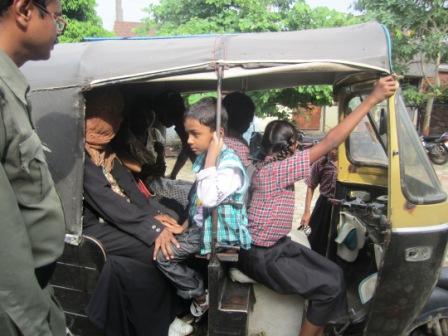 The big day arrives
The big day arrives
On the way, the children thought about questions to ask the doctors at Sambhavna. They enjoyed the journey from their school to the clinic and had a bit of rollercoaster ride because of the bad condition of Chola Road. Most of all the children were asking their teachers about lunch! The majority of the children were bagless but some of them have their notebooks with them. When they entered the clinic and saw the patients waiting, they suddenly became silent. If any of the kids started talking, others kept them quiet, “Ssshhhhh…chup raho, hum clinic mai hain!”
What’s it all about?
Some of them had visited the clinic before but for others this is their first visit. Stephanie and their teachers start the tour in the library where they introduce Shahnaz (‘In Charge’ of the library) and learn more about it: how it works, what it’s role is in Sambhavna, what is kept here, why it is important and more.
Next the children go to the conference room where they sit quietly on the chairs. Most were new to the conference room and some were looking up at the high roof. Then Shahnaz talked to the group about malaria and its prevention, ways of maintaining hygiene and also how we are exposed to chemicals in our daily life as well as how to escape them.
 Then there is a very interesting session on herbal neem stick (agarbatti) by Nandu Bhai. The children are very interested to know about the effects of mosquito coils on their health. All of them tried to make a neem stick. They got their notebooks out and wrote all the necessary notes. Chandrakanta gave a single neem agarbatti to all the children.
Then there is a very interesting session on herbal neem stick (agarbatti) by Nandu Bhai. The children are very interested to know about the effects of mosquito coils on their health. All of them tried to make a neem stick. They got their notebooks out and wrote all the necessary notes. Chandrakanta gave a single neem agarbatti to all the children.
After that the children visited the yoga room, the deewar patrika section (a ‘magazine’ wall in front of the yoga room where people’s contributions of posters and writing are put up), the managing trustee’s office, the accounts office, the computer room and more. They asked questions like, ‘How do you give the salary? How are the computers connected? What does the registration department do? and more.
We all need to play!
They saw the table tennis room where Dr Quaiser and Dr Jai were playing, some of them had never seen table tennis before! I asked them what they did in their lunchtimes? They said we play games and just enjoy the time. I explained that the doctors and other staff of staff also need to play. It used to be that most of the staff went out to have lunch, now, since we got the table tennis table, more stay to chat and play.
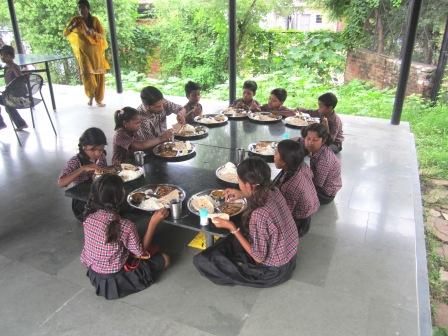 While the staff had their lunch the children enjoyed the clinic playground especially the seesaw and the tyre bridges. They forgot everything and just enjoyed themselves. Playing increased their appetite and then it was their turn to have lunch. Plates by plates the lunch arrived on the table and in time their little stomachs are filled with the food. They were very thankful to the clinic for giving such good food some of them said: “After a very long time we have such a nice lunch.”
While the staff had their lunch the children enjoyed the clinic playground especially the seesaw and the tyre bridges. They forgot everything and just enjoyed themselves. Playing increased their appetite and then it was their turn to have lunch. Plates by plates the lunch arrived on the table and in time their little stomachs are filled with the food. They were very thankful to the clinic for giving such good food some of them said: “After a very long time we have such a nice lunch.”
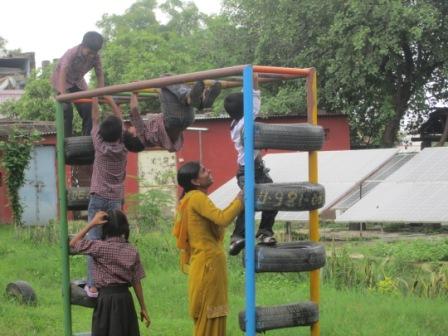 After lunch we went out into the garden but first I want to share something with you my friends. When Stephanie first visited the Oriya Basti Garden she found that the children were not very interested in it, and that they rarely visited the garden, they didn’t have much knowledge about plants; their teacher also needed more information about the garden and the plants and to learn more. As a result the garden was losing its beauty. So Stephanie her work cut out for her and decided that a school visit to Sambhavna was needed. She discussed it with Sathyu (Sambhavna’s managing trustee) and the doctors and finally a visit of was planned. The main aim was to inspire the children to learn more about the plants, and how to maintain the garden.
After lunch we went out into the garden but first I want to share something with you my friends. When Stephanie first visited the Oriya Basti Garden she found that the children were not very interested in it, and that they rarely visited the garden, they didn’t have much knowledge about plants; their teacher also needed more information about the garden and the plants and to learn more. As a result the garden was losing its beauty. So Stephanie her work cut out for her and decided that a school visit to Sambhavna was needed. She discussed it with Sathyu (Sambhavna’s managing trustee) and the doctors and finally a visit of was planned. The main aim was to inspire the children to learn more about the plants, and how to maintain the garden.
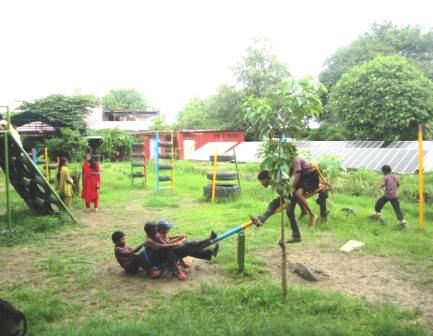 Unpoisoning humankind
Unpoisoning humankind
So finally the group are in Sambhavna’s garden with their teachers, very happily making notes about various plants. Some said how long the garden was and that they would have to visit it again and again to know more; some asked the gardeners questions; others noticed plants that were is their school garden.
After the garden kids went to the Golghar, there first Dr Roopa tells them about the Pancha Tattva (five elements: Prathvi (earth), Jala (water), Agni (fire), Vayu (air) and Akash (Sky) and their relationships with our bodies using Shaktiman as an example (he’s a very famous fictional character, an Indian television superhero). His body comprises of five elements, so it’s a simple way to explain the Pancha Tattva. Then she talked about Tridosha and health effects. Ayurveda stresses a balance of three elemental energies or humors: vata (air & space – “wind”), pitta (fire & water – “bile”) and kapha (water & earth – “phlegm”). She told them how, according to ayurvedic medical theory, these three substances are important for health, because when they exist in equal quantities, the body will be healthy, and when they are not in equal amounts, the body will be unhealthy in various ways.
Dr Jai joined the group later and asked them about medicinal plants and how they use them as local remedies. Most of them replied with their known plants like adusa (Adhatoda vasica), giloy (Tinospora cordifolia), tulsi (Ocimum tenuiflorum), neem (Azadirachta indica), gudhal (Hibiscus rosa-sinensis), safed musli (Chlorophytum borivillianum), gwarpatha (Aloe barbadensis) and many more with its uses. Everyone really enjoyed all the sessions. Last we have a group photo!
Learning and improving all round
When I talked with Triveni 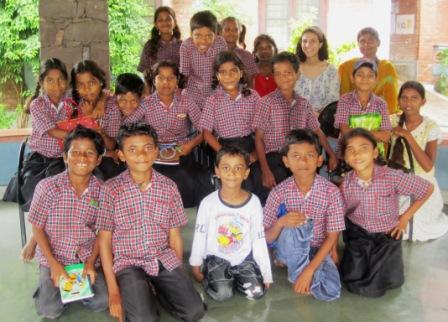 Sonani and Tasneem Khan they told me that the trip was superb for them. Everyone enjoyed the herbal neem stickmaking, learned alot about the plants and made lots of notes. Tasneem laughed and said that her son Rizwan liked the toilet alot; he went there again and again. He also liked the garden very much, he was just running in the garden here and there, all over the garden.
Sonani and Tasneem Khan they told me that the trip was superb for them. Everyone enjoyed the herbal neem stickmaking, learned alot about the plants and made lots of notes. Tasneem laughed and said that her son Rizwan liked the toilet alot; he went there again and again. He also liked the garden very much, he was just running in the garden here and there, all over the garden.
The teachers also said that eating together was a very lovely feeling for them. When we were talking about visiting the clinic the children were asking us all kinds of questions like: What are we going to see? If it’s raining how will we get there? but the most important question for them was where we would have our lunch! And when we went back to the Oriya Basti they asked: When will we visit there again? Can we learn neem stick preparation here at our Oriya Basti School? And can we also take treatment from the clinic?
Hey, something is missing here, who are our kids the children in this story? Okay, so they are: Kiran, Mansi, Rakhi, Sujeet, Suneel, Prakash, Tapan, Devdutt, Veeru, Chanchal, Bharti, Jaswant, Dhanmati, Preeti, Meenakchi and the youngest one Rizwan.
The children are inspired
 I visited their school in Oriya Basti with Stephanie a week after their trip to Sambhavna. I asked them how their visit was. They all screamed: “Bahut achhi!” (very nice).
I visited their school in Oriya Basti with Stephanie a week after their trip to Sambhavna. I asked them how their visit was. They all screamed: “Bahut achhi!” (very nice).
 I asked them what they had seen there. Everyone started talking at once! someone said Jhula (Swing), agarbatti (Neem stick), table tennis and more. Then they started telling me the names of plants. I was surrounded by the children, each one saying different names of plants… there were so many voices at a same time! Some of them were repeating their friend’s plant’s name. I said to them okay, let’s play a game; you tell me three names of plants that you have seen in the garden and everyone will have a turn, so tell me one by one, and the children started telling me the plant names in a rhythm. It was a very lovely feeling. They were filled with confidence, really enjoying themselves and very happy.
I asked them what they had seen there. Everyone started talking at once! someone said Jhula (Swing), agarbatti (Neem stick), table tennis and more. Then they started telling me the names of plants. I was surrounded by the children, each one saying different names of plants… there were so many voices at a same time! Some of them were repeating their friend’s plant’s name. I said to them okay, let’s play a game; you tell me three names of plants that you have seen in the garden and everyone will have a turn, so tell me one by one, and the children started telling me the plant names in a rhythm. It was a very lovely feeling. They were filled with confidence, really enjoying themselves and very happy.
 The Oriya Basti School children remember so many things about their trip to Sambhavna. It’s wonderful to see how much interest the children have in the plants now; they visit their garden regularly, sometimes with Stephanie’s camera to take pictures of flowers and plants. And they’ve made some beautiful drawings of the plants from their garden with uses as local remedies. Huge thanks to Stephanie, the teachers and all the children. I hope more volunteers come to Sambhavna to maintain these children’s enthusiasm and develop the possibilities that Sambhavna has for connecting with the wider community.
The Oriya Basti School children remember so many things about their trip to Sambhavna. It’s wonderful to see how much interest the children have in the plants now; they visit their garden regularly, sometimes with Stephanie’s camera to take pictures of flowers and plants. And they’ve made some beautiful drawings of the plants from their garden with uses as local remedies. Huge thanks to Stephanie, the teachers and all the children. I hope more volunteers come to Sambhavna to maintain these children’s enthusiasm and develop the possibilities that Sambhavna has for connecting with the wider community.
If you would like any more information about the herbs mentioned here or any of Sambhavna’s treatments please do get in touch.
Stephanie has now left Sambhavna and is working on a bigger report which we’ll be publishing soon. Here’s her Oxygène blog which includes missives from Bhopal.


